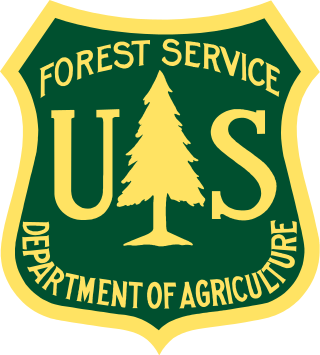
The United States Forest Service (USFS) is an agency within the U.S. Department of Agriculture that administers the nation's 154 national forests and 20 national grasslands covering 193 million acres (780,000 km2) of land. The major divisions of the agency are the Chief's Office, National Forest System, State and Private Forestry, Business Operations, as well as Research and Development. The agency manages about 25% of federal lands and is the sole major national land management agency not part of the U.S. Department of the Interior.
In all modern states, a portion of land is held by central or local governments. This is called public land, state land, or Crown land. The system of tenure of public land, and the terminology used, varies between countries. The following examples illustrate some of the range.
The National Forest Adventure Pass is a recreation fee pass issued by the United States Forest Service that permits bearers in designated regions of four National Forests in Southern California to park their cars for the purpose of recreation. Though it was introduced during the "Recreation Fee Demonstration Program" (Fee-Demo) which ended on November 21, 2004, the Forest Service continues to administer the program, nearly unchanged, under the Federal Lands and Recreation Enhancement Act. This act, derisively dubbed by some as the "Recreation Access Tax" (RAT), was passed in December 2004 as part of the Omnibus Appropriations Bill. The four national forests it applies to are the Angeles National Forest, Cleveland National Forest, Los Padres National Forest and San Bernardino National Forest.

The National Trails System is a series of trails in the United States designated "to promote the preservation of, public access to, travel within, and enjoyment and appreciation of the open-air, outdoor areas and historic resources of the Nation". There are four types of trails: the national scenic trails, national historic trails, national recreation trails, and connecting or side trails. The national trails provide opportunities for hiking and historic education, as well as horseback riding, biking, camping, scenic driving, water sports, and other activities. The National Trails System consists of 11 national scenic trails, 21 national historic trails, over 1,300 national recreation trails, and seven connecting and side trails, as well as one national geologic trail, with a total length of more than 91,000 mi (150,000 km). The scenic and historic trails are in every state, and Virginia and Wyoming have the most running through them, with six.

A national recreation area (NRA) is a protected area in the United States established by an Act of Congress to preserve enhanced recreational opportunities in places with significant natural and scenic resources. There are 40 NRAs, which emphasize a variety of activities for visitors, including hiking, camping, boating, fishing, swimming, biking, horseback riding, and wildlife viewing, in areas that include multiple-use management for both conservation and limited utilization of natural resources. They have diverse features and contexts, being established around reservoirs, in urban areas, and within forests. Due to their size, diversity of activities, and proximity to population centers, NRAs are among the most visited units of the National Park System, with six among the thirty most visited sites.

The Conecuh National Forest in southern Alabama covers 83,000 acres (340 km2), along the Alabama - Florida line in Covington and Escambia counties. Topography is level to moderately sloping, broad ridges with stream terraces and broad floodplains.

Prince William Forest Park is a national park in the U.S. state of Virginia within Prince William County, located adjacent to the Marine Corps Base Quantico near the town of Dumfries. Established as Chopawamsic Recreational Demonstration Area in 1936, the park is the largest protected natural area in the Washington, D.C. metropolitan region at over 13,000 acres (5,300 ha).

Superior National Forest, part of the United States National Forest system, is located in the Arrowhead Region of the state of Minnesota between the Canada–United States border and the north shore of Lake Superior. The area is part of the greater Boundary Waters region along the border of Minnesota and the Canadian province of Ontario, a historic and important thoroughfare in the fur trading and exploring days of New France and British North America.

First Landing State Park offers recreational opportunities at Cape Henry in the independent city of Virginia Beach, Virginia. As the first planned state park of Virginia, First Landing is listed on the National Register of Historic Places as Seashore State Park Historic District. A portion of the park is listed as a National Natural Landmark as part of the Seashore Natural Area.
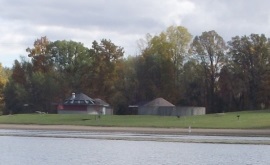
Bald Mountain State Recreation Area is a 4,637-acre (1,877 ha) state park located near Lake Orion, Michigan off M-24. It consists of some of the most rugged terrain in southeastern Michigan. The recreation area is composed of a North Unit and a South Unit, which are not contiguous. The South Unit itself includes two parts separated by M-24, but the section west of M-24 has no recreational facilities or trails and is primarily undeveloped forest and grassy plains segmented by a few through-roads.

June Lake is an unincorporated community and census-designated place (CDP) in Mono County, California, United States. It is located against the southern rim of the Mono Basin, 12.5 miles (20 km) south of Lee Vining, at an elevation of 7,654 feet (2,333 m).

The Musick Guard Station is a rustic cabin located in the Umpqua National Forest in western Oregon, United States. It was originally built to house fire crews assigned to patrol the surrounding National Forest. In the 1990s, the United States Forest Service began renting Musick Guard Station to recreational visitors. The Musick Guard Station is listed on the National Register of Historic Places.
The Occupancy Permits Act was passed on March 4, 1915, by the 63rd United States Congress. It allowed the U.S. Forest Service to issue to cabin permits at "reasonable rates" to individuals who had had their property taken through eminent domain. Permits could be issued for periods of up to 30 years. Individuals were encouraged to build homes within the boundaries of national parks in order to widen the Forest Services' work in recreational management. It is the basis of the USFS Recreation Residences program.
Haskell Creek Homesites is a USDA Forest Service Recreational Residence cabin tract in Sierra County, California, United States. Haskell Creek Homesites is 6.5 miles (10.5 km) northeast of Sierra City, near the mouth of Haskell Creek, a tributary of the North Fork of the Yuba River.
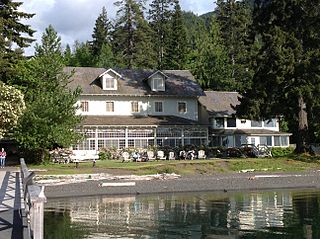
Lake Crescent Lodge, originally called Singer's Lake Crescent Tavern, is a historic resort situated on the shores of Lake Crescent west of Port Angeles, Washington. Located on the Olympic Peninsula within Olympic National Park, the Lodge is owned by the National Park Service and operated by Aramark. The Lodge resort is open seasonally from early May until the end of January with select cabins available during the winter months. Hiking and boating are popular activities for guests, and several peaks, including Mount Storm King and Pyramid Mountain, are easily accessible from the resort. Other hiking opportunities include Marymere Falls, Spruce Railroad, and Barnes Creek Trails.
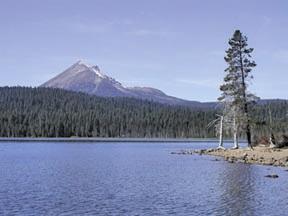
Lake of the Woods is a natural lake near the crest of the Cascade Range in the Fremont–Winema National Forest in southern Oregon in the United States. The lake covers 1,146 acres (4.64 km2). It was named by Oliver C. Applegate in 1870. Today, the Oregon Department of Fish and Wildlife manages the lake's fishery. The small unincorporated community of Lake of the Woods is located on the east shore of the lake. Lake of the Woods is one of southern Oregon's most popular outdoor recreation sites.

Lonesomehurst Cabin is a log cabin style recreational residence on the west side of the South Fork Arm of Hebgen Lake near West Yellowstone, in Gallatin County, Montana. Hebgen Lake is on the Madison River. There are three buildings on the site: a wood-frame cabin constructed circa 1919, a log boathouse built in 1958, and a wood frame outhouse built about 1930. The cabin is at the south end of the site, which is 8 miles (13 km) west of West Yellowstone and the entrance to Yellowstone National Park.
Madera Canyon is a formerly populated place situated in the Santa Rita Mountains of Santa Cruz County, Arizona, United States. It has an estimated elevation of 4,911 feet (1,497 m) above sea level. It is located within a canyon of the same name, Madera Canyon, in the Coronado National Forest.
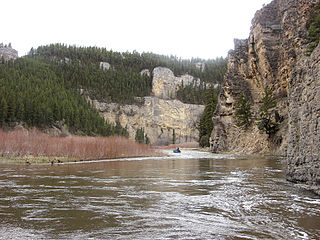
Smith River State Recreational Waterway, popularly known as the Smith River State Park, is a protected river corridor and "virtual park" owned and operated by the state of Montana in the United States. The site is not officially a state park, but rather a State Recreational Waterway and managed River Corridor. The park consists of the state-owned Smith River; a Montana Department of Fish, Wildlife and Parks (FWP) put-in access point, Camp Baker; 27 FWP-owned and -leased boat camps on the shore of the river; and the FWP-owned Eden Bridge take-out point. Little of the area is owned by FWP. Much of the surrounding shoreline is owned by the United States Forest Service, United States Bureau of Land Management, and private owners. Through management agreements with other government agencies and private landowners, FWP manages the 58.9-mile (94.8 km) Smith River Corridor as a "virtual state park". The Smith River is the only river in the state of Montana where a permit is required to boat or float on the river.
Greenwood Lodge is a Rustic-style log cabin lodge which dates from 1932, in the Arapaho National Forest and Roosevelt National Forest in Grand County, Colorado, in the vicinity of Grand Lake, Colorado, US. It has also been known as Spence Cabin. The lodge was listed on the National Register of Historic Places in 2010.














